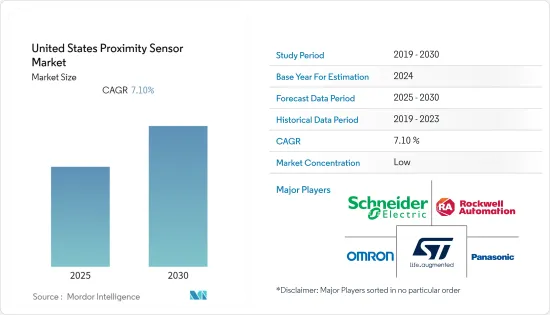Need help finding what you are looking for?
Contact Us
PUBLISHER: Mordor Intelligence | PRODUCT CODE: 1627136

PUBLISHER: Mordor Intelligence | PRODUCT CODE: 1627136
United States Proximity Sensor - Market Share Analysis, Industry Trends & Statistics, Growth Forecasts (2025 - 2030)
PUBLISHED:
PAGES: 120 Pages
DELIVERY TIME: 2-3 business days
SELECT AN OPTION
The United States Proximity Sensor Market is expected to register a CAGR of 7.1% during the forecast period.

Key Highlights
- In the United States, modern facilities are becoming more complex and diverse with urbanization and population growth. For instance, according to a world development indicators survey conducted by the World Bank, it was found that the degree of urbanization in the United States was 82.66% in 2020.
- The sensor information data would aid in managing various urban facilities and the effective response to emergencies and accidents through information sharing. Intelligent urban vehicles would require multiple sensors to monitor a variety of phenomena. These various types of proximity sensors constantly monitor the position and control of the vehicle, increasing their demand in urban infrastructures and propelling the proximity sensor market forward.
- Moreover, in the era of technological advancement, new innovative proximity sensors - Time of Flight (ToF) sensors - can protect health in various ways while maintaining social distance. For instance, STMicroelectronics introduced high-performance proximity and ranging sensors based on FlightSense Time of Flight technology in July 2020. These Time of Flight (ToF) sensors aid in developing 3D sensing capabilities for a wide range of products used by customers daily.
- Further, with the growing impact of COVID-19 on various industries, businesses are following social distance through advanced technologies. As a result of the pandemic, the demand for proximity sensors has increased as they improve workplace safety and ensure contact tracing through proximity detection tags to ensure business continuity.
- However, designing miniaturized sensors without affecting their quality poses a challenge for the proximity sensor market growth.
US Proximity Sensor Market Trends
The Automotive Segment is Expected to Drive the Market's Growth
- Proximity sensors are widely used in automotive applications to detect objects close to vehicles. These sensors alert the driver and provide information about the vehicle's status. Engine temperature, battery charging check, speed control, fuel level, and other prominent applications of proximity sensors in automobiles include the following. In some cases, these sensors are installed on doors and handle to detect objects in the event of a collision or warning.
- Further, autonomous technologies, such as parking assist systems and ADAS, use a variety of sensors, such as temperature sensors, motion detectors, photon sensors, and so on. These sensors are critical to autonomous systems because they generate the data required for efficient and accurate operation.
Inductive Proximity Sensor is Expected to Hold a Major Market Share
US Proximity Sensor Industry Overview
Additional Benefits:
Product Code: 49952
TABLE OF CONTENTS
1 INTRODUCTION
- 1.1 Study Assumptions and Market definitions
- 1.2 Scope of the Study
2 RESEARCH METHODOLOGY
3 EXECUTIVE SUMMARY
4 MARKET DYNAMICS
- 4.1 Market Overview
- 4.2 Industry Attractiveness - Porter's Five Forces Analysis
- 4.2.1 Threat of New Entrants
- 4.2.2 Bargaining Power of Buyers
5 MARKET DYNAMICS
6 MARKET SEGMENTATION
7 COMPETITIVE LANDSCAPE
8 INVESTMENT ANALYSIS
9 FUTURE OUTLOOK
Have a question?


SELECT AN OPTION
Have a question?


Questions? Please give us a call or visit the contact form.
